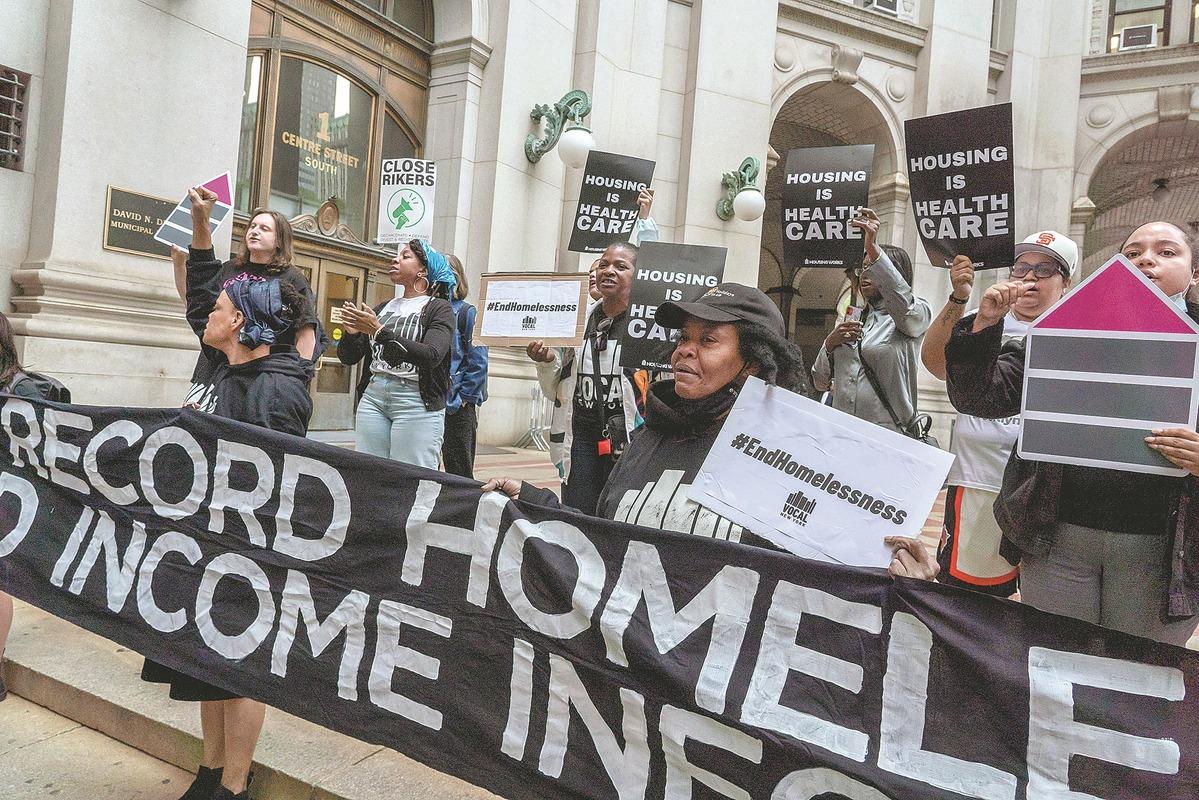 Protesters carry placards and banners, calling to end homelessness, outside the City Hall during a rally in New York on May 24. (PHOTO / NEWSCOM)
Protesters carry placards and banners, calling to end homelessness, outside the City Hall during a rally in New York on May 24. (PHOTO / NEWSCOM)
NYC, LA faced with fund crunch to tackle problem caused by migrant influx, layoffs
In a tale of two cities, New York and Los Angeles, the largest and second-largest cities in the United States, where the rich live alongside the less fortunate, homelessness has become a crippling issue that local governments are struggling to deal with.
The number of homeless people in New York has reached levels not seen since the Great Depression of the 1930s, said the Coalition for the Homeless based in New York, the country's oldest advocacy and direct service organization that helps the homeless.
ALSO READ: US officials prepping legislation to revamp asylum system
A record 100,000 people are living in homeless shelters for the first time, city officials said on June 28, mainly after a huge influx of migrants from the southern border were mostly bused into the city from Republican states beginning in spring last year.
Jose, a migrant from Venezuela who asked to drop his last name for fear of his family's safety, arrived in New York in October. He has no official status, cannot work and has no place to live.
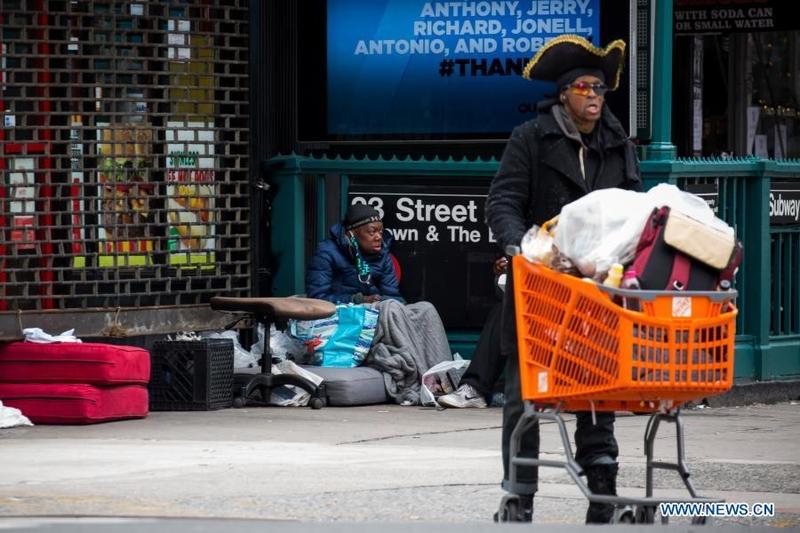 Homeless people located near a subway station in New York, the United States, April 27, 2020. (PHOTO / XINHUA)
Homeless people located near a subway station in New York, the United States, April 27, 2020. (PHOTO / XINHUA)
However, he is adamant that he cannot return to Venezuela where he was a truck driver, as gangs told him they would kill him, nonprofit National Public Radio reported in March.
We have seen an uptick in the number of people needing help over the past 10 months. Part of that has been migrants, but also as the cost of rent in the city continues to skyrocket, more and more people are just not able to afford rent.
Corey Hayes, Creative Director, City Relief
About 52,000 migrants are among New York's homeless population, making them the largest group of unhoused people in the city's system. More than two-thirds have families and children with them, Deputy Mayor Anne Williams-Isom told a news conference last month.
To handle the crisis, Mayor Eric Adams said $1.4 billion has already been spent to provide housing for migrants this year. The city expects to spend at least $4.4 billion overall to address the issue by next year. He acknowledged that the funding is taking away from social services.
"I just think it's unfair — $1.4 billion that could have gone into some of the priorities that we all share," he told The New York Times on June 29.
City Relief, a nonprofit founded in 1989, provides meals from a local mobile van at eight locations, including Chelsea, the Lower East Side and Chinatown, West 14th Street, South Bronx and Harlem in New York City as well as several more places in New Jersey. It relies on donations through its website and encourages people to volunteer.
ALSO READ: High tolerance of hate worries US homeland security head
Corey Hayes, creative director for the organization, told China Daily: "We have seen an uptick in the number of people needing help over the past 10 months. Part of that has been migrants, but also as the cost of rent in the city continues to skyrocket, more and more people are just not able to afford rent."
Many of the people who have newly arrived are living in 166 locations, including converted hotels, hospitals or one of 11 large relief centers across the city. It costs the city $8 million a day.
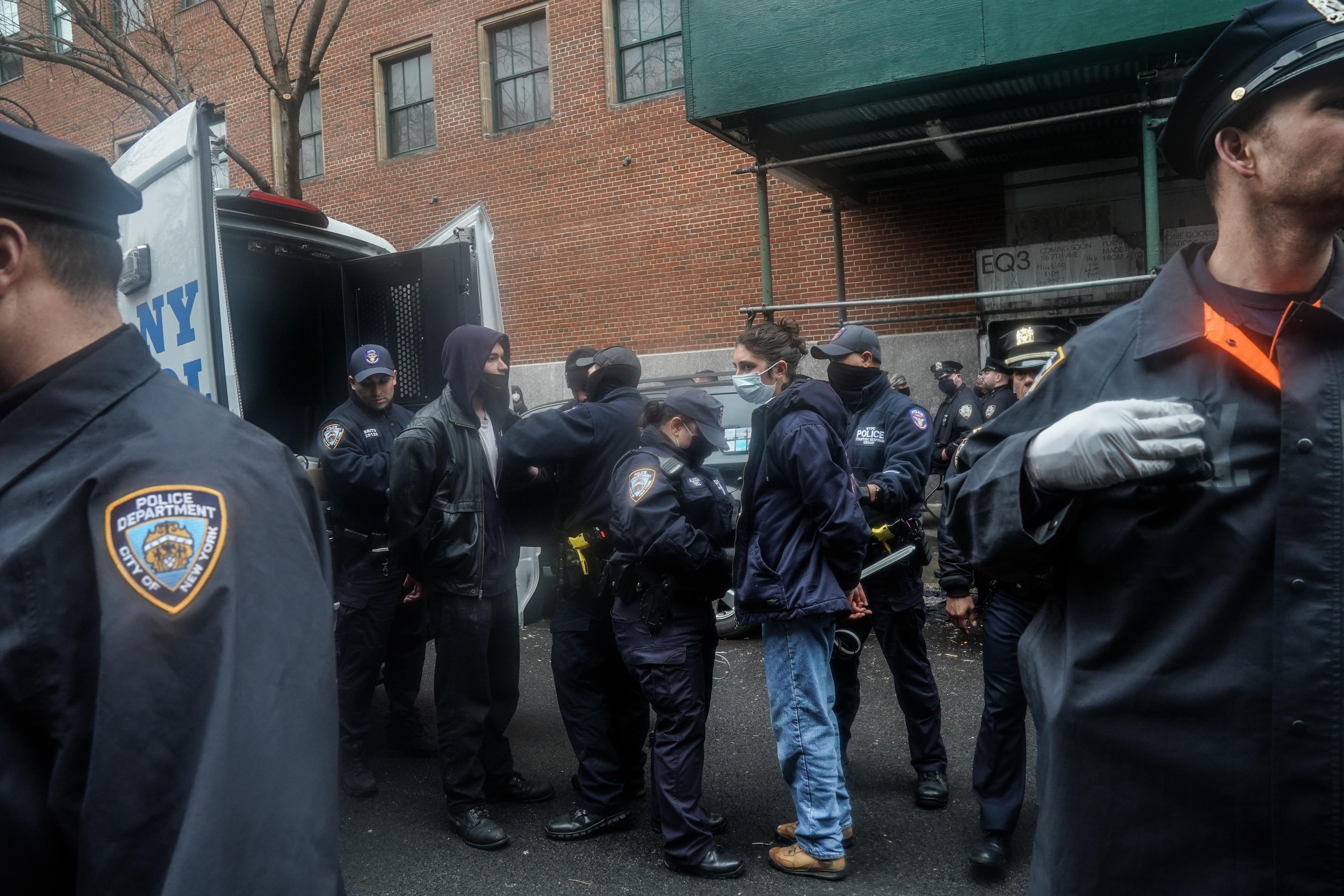 Homeless people and their supporters are arrested as Mayor Eric Adams orders homeless camps removed in the East Village on April 6, 2022 in New York. (PHOTO / AFP)
Homeless people and their supporters are arrested as Mayor Eric Adams orders homeless camps removed in the East Village on April 6, 2022 in New York. (PHOTO / AFP)
On July 11, Adams announced two new Humanitarian Emergency Response and Relief centers that will cater to migrants, including 330 families with children seeking asylum.
"New York City continues to receive thousands of asylum-seekers each week, and we continue to do everything in our power to respond accordingly, but we are still in dire need of assistance from our state and federal partners," he said in a statement.
Adams, along with lawmakers, also announced a $107 billion budget for the new fiscal year beginning on July 1. But it includes cuts to nonprofits that the Department of State uses to run its shelters. This was criticized by several organizations, including Homeless Services United, a nonprofit in New York.
At my main job, I work about 30 hours a week, my other job is along the same lines. The thing is the money I make on the side is not extra money because living in New York is really very expensive. I just have enough to cope.
Junior Phillips, 49, from Brooklyn
Last month, the mayor used an executive order to eliminate a rule that had required homeless shelter residents to wait 90 days before they could get a "Family Homelessness & Eviction Prevention Supplement", or a rental assistance voucher funded by the city.
He also vetoed other bills aimed at expanding eligibility for the vouchers to people at risk of eviction and to alter the income requirement of people who wanted them.
ALSO READ: Migrant crossings drop at US-Mexico border after Title 42 expiry
However, his veto was overridden by the New York City Council on July 13. He estimated that all the bills could cost the city $17 billion over the next five years, which he said was unsustainable.
The mayor has also faced criticism for supporting rent increases for 2 million people in rent-stabilized apartments, which advocates believe will affect those on a low income already struggling to pay rent and buy food.
"Often people will come to us just because the rent doesn't allow them enough money to eat," Hayes said. "The city has failed to invest in increased housing over the past number of years and wasn't ready for either situation."
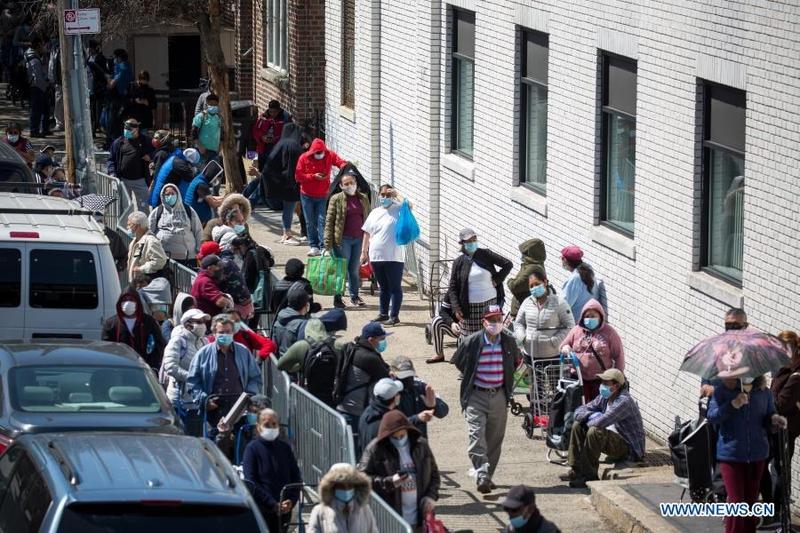 People wait to receive food at a food distribution site in the Brooklyn borough of New York, the United States, May 14, 2020. (PHOTO / XINHUA)
People wait to receive food at a food distribution site in the Brooklyn borough of New York, the United States, May 14, 2020. (PHOTO / XINHUA)
Junior Phillips, 49, from Brooklyn, installs flooring in homes and businesses for a living. He has a full-time job and does part-time work to cope with the cost of rent and rising bills.
"At my main job, I work about 30 hours a week," Phillips told China Daily. "My other job is along the same lines. The thing is the money I make on the side is not extra money because living in New York is really very expensive. I just have enough to cope."
In addition to asylum-seekers, 80,000 non-immigrants are homeless in the Big Apple, which equates to 1 in 80 people not having a permanent home. Many would go hungry if it were not for the help of homeless outreach programs such as City Relief.
At least 3,000 "vulnerable" homeless people in the city who suffer from mental health problems live on the streets and can often be seen living on subways
"Our main focuses are providing hot meals for people to make it through the day, and connections to local resources to help them create a future off the streets," Hayes said. "I've had many people tell me over the years that they would have died without our assistance."
Mental health issues
At least 3,000"vulnerable" homeless people in the city who suffer from mental health problems live on the streets and can often be seen living on subways.
The plight of this group, known and monitored by the city, came to the fore this year after Jordan Neely, a 30-year-old homeless man, was choked to death on May 1 on a train by Daniel Penny, a 24-year-old former US Marine.
Eyewitnesses said Neely had been shouting and complaining on the subway that he had no food. The Michael Jackson impersonator had been homeless for numerous years after his mother was killed by her boyfriend. He had been on drugs and was in trouble with the law after being arrested 42 times.
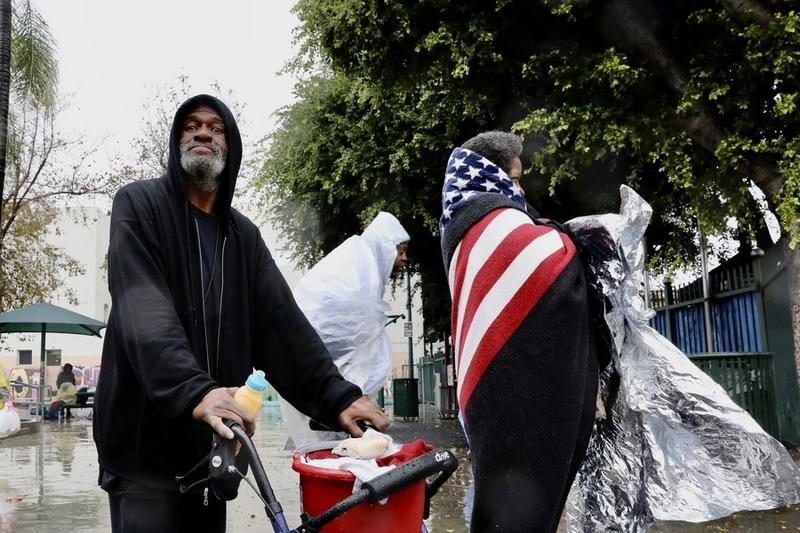 Homeless people in Los Angeles, California, the United States on Jan 10, 2023. (PHOTO / XINHUA)
Homeless people in Los Angeles, California, the United States on Jan 10, 2023. (PHOTO / XINHUA)
Last month, Penny was indicted on second-degree manslaughter and criminally negligent homicide. His case has divided opinion between some who think he is a hero and others who believe he "lynched" Neely, such as Yusef Salaam, a politician.
Hayes said: "It's so important that people remain compassionate (toward the homeless). As homelessness grows due to housing shortages, geopolitical crisis and climate change, we've found people become less tolerant toward those experiencing homelessness.
READ MORE: US warns domestic extremists could exploit easing virus curbs
"They see more people on the street and have less compassion for their situation, feeling that the person must somehow be at fault."
Thousands of kilometers away on the West Coast, Los Angeles is known worldwide for its opulence, celebrities and sunshine. However, it has another side — the homeless. In some areas, along backstreets, hundreds of tents form makeshift cities where hundreds of people sleep.
Last month, Los Angeles Mayor Karen Bass said the city's preliminary figures showed that the number of homeless people living in a tent, car or temporary homes in Los Angeles County was 75,518 as of January, up from 69,144 the previous year.
"The challenge before us is vast, but we will continue to work with urgency to bring Angelenos inside," Bass said. "Lives depend on it."
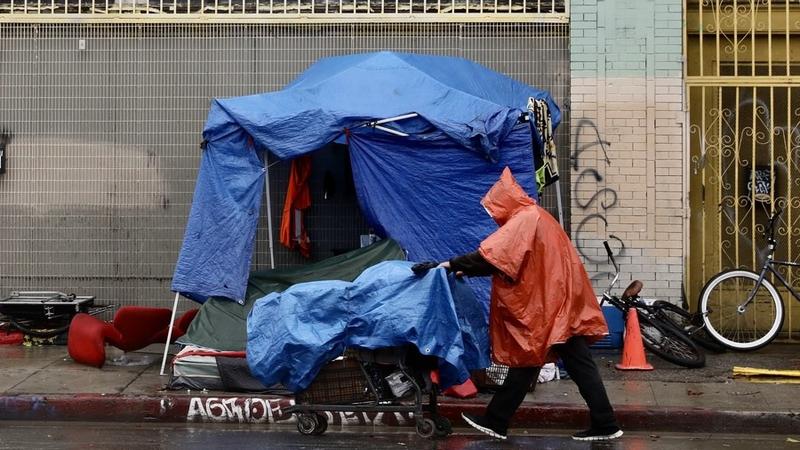 A homeless person walks in the rain along 6th Street in downtown Los Angeles, California, the United States, Jan 10, 2023. (PHOTO / XINHUA)
A homeless person walks in the rain along 6th Street in downtown Los Angeles, California, the United States, Jan 10, 2023. (PHOTO / XINHUA)
Overall, homelessness has increased by 9 percent in LA County and 10 percent in the city of Los Angeles last year.
This is despite hundreds of millions of dollars being spent on housing the homeless, said a report by the Los Angeles Homeless Services Authority. It has not decreased the camps full of homeless people on the streets.
A lack of affordable housing is the primary driver of homelessness in LA, which is a result of decades of underinvestment in affordable housing and insufficient urban planning for the population growth experienced in LA and California more broadly.
Benjamin Henwood, Professor, The University of Southern California
In January, volunteers carried out a count of the homeless. Compared with a similar count done in 2015, the number of unhoused people had increased by 80 percent in the city and 70 percent in the county.
Homelessness in Los Angeles is often spurred by people losing their jobs and not being able to pay their rent, like New York, a study by researchers at the University of California San Francisco found.
Benjamin Henwood, a professor of the Suzanne Dworak-Peck School of Social Work at the University of Southern California, told China Daily, "A lack of affordable housing is the primary driver of homelessness in LA, which is a result of decades of underinvestment in affordable housing and insufficient urban planning for the population growth experienced in LA and California more broadly."
READ MORE: 'Silver tsunami' sweeps US with sizeable seniors
The areas in LA with the highest homeless population include South LA, Westside and Harbor areas, the Los Angeles Times reported last month. Unlike New York, the number of people in shelters was just 20,000 county-wide, but the number of those living on the street out of shelters was more than 55,000.
The COVID-19 pandemic was challenging, but homelessness has been bad for more than 10 years and continues to soar, Henwood said.
Upward trend
"In the immediate aftermath of COVID, we did not see a large increase in homelessness as evidenced by the 2022 homeless count," he said. "The 2023 estimate points to a resumption of a continuous upward trend over the past 10 years with the homelessness population doubling during that time.
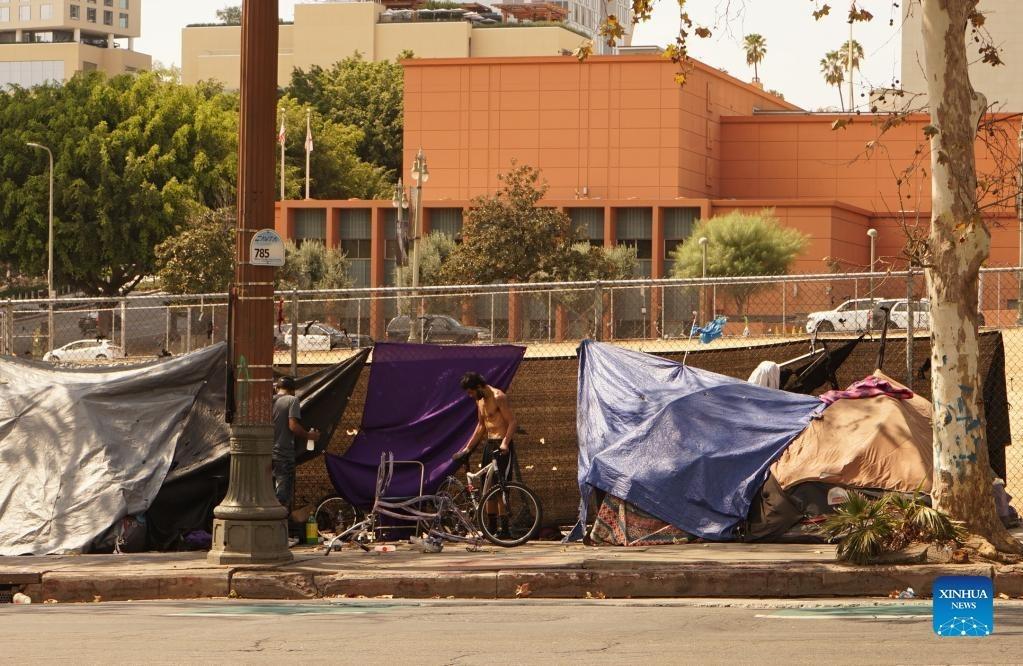 The homeless tents line the sidewalk of a street in downtown Los Angeles, California, the United States, on Sept 8, 2022. (PHOTO / XINHUA)
The homeless tents line the sidewalk of a street in downtown Los Angeles, California, the United States, on Sept 8, 2022. (PHOTO / XINHUA)
"COVID-19 pandemic aid, including cash payments and an eviction moratorium, interrupted this trend, but growing income inequality and a housing market that can't accommodate low-wage earners (have) resulted in a resumption of this upward trend."
About 27,000 people living on the streets in Los Angeles have been there for more than a year, the count showed, and much like New York, many are suffering poor health, mental health woes and substance abuse. Around 25 percent of homeless people said they had severe mental illness, and 30 percent said substance abuse was an issue, officials said.
The racial makeup of those in homeless shelters was about 43 percent Latino, 31 percent black, 24 percent white and 2 percent Asian.
Many workers in other areas in California, such as Silicon Valley, could not put food on the table while paying rent after a loss of income amid the pandemic, according to local food banks. Tech companies, many of which have headquarters in the state, also had massive layoffs
Many workers in other areas in California, such as Silicon Valley, could not put food on the table while paying rent after a loss of income amid the pandemic, according to local food banks. Tech companies, many of which have headquarters in the state, also had massive layoffs.
READ MORE: US seeks Canadian help to ease crowding at US-Mexico border
Diane Baker Hayward, a spokeswoman for Second Harvest of Silicon Valley in California, one of the largest food banks in the US, said the aftermath of the pandemic put a huge strain on families that had to turn to food banks.
Second Harvest serves people in San Jose, Santa Clara and San Mateo counties, including Silicon Valley and the San Francisco Peninsula.
"This high level of need was due in large part to the very high cost of housing in Santa Clara and San Mateo Counties — what many refer to as Silicon Valley," Hayward told China Daily.
"When the pandemic hit, many people lost their jobs or had hours cut at work. Many of the people we are seeing now have never received food assistance before."
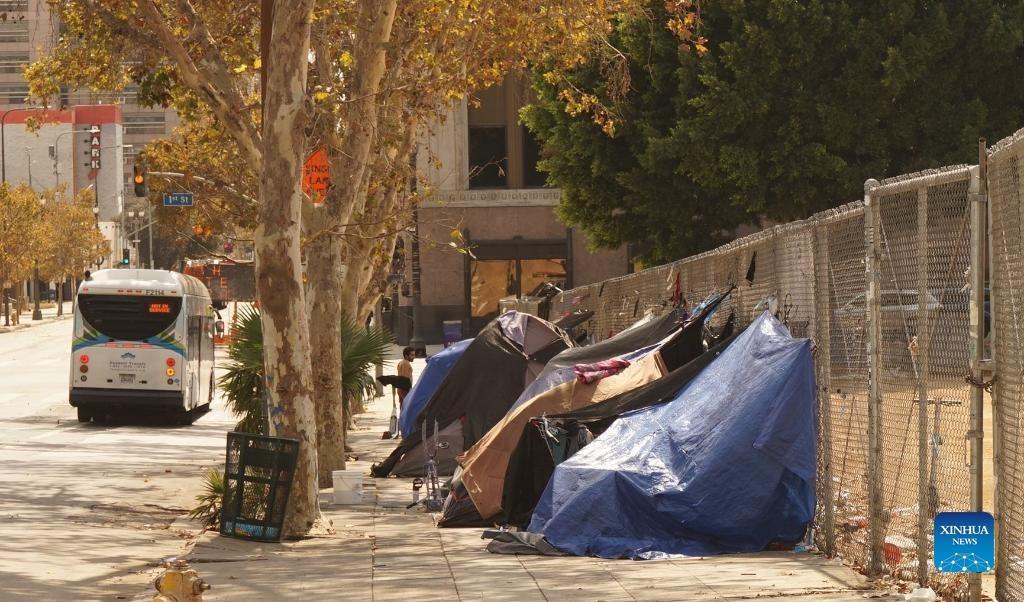 The homeless tents line the sidewalk of a street in downtown Los Angeles, California, the United States, on Sept 8, 2022. (PHOTO / XINHUA)
The homeless tents line the sidewalk of a street in downtown Los Angeles, California, the United States, on Sept 8, 2022. (PHOTO / XINHUA)
Mayor Bass said she and her team have moved 14,000 people off the streets in the first six months of this year. At least 30 percent, or 4,332, got permanent housing, and a further 10,049 went into interim housing from December to May.
However, Henwood believes that to solve the problem in the long run, "more needs to be done at every level of government".
"A recent report provided an estimate that the state of California needs to commit $6.9 billion to affordable housing annually for the next 12 years to address homelessness when it currently only commits $1.2 billion to affordable housing," he said.


